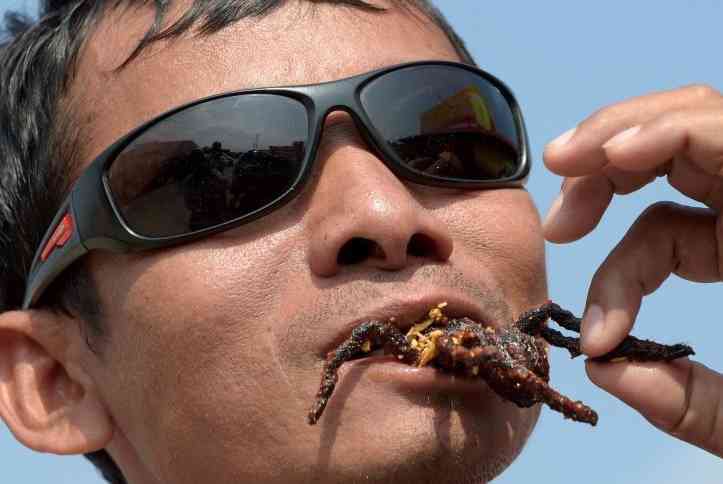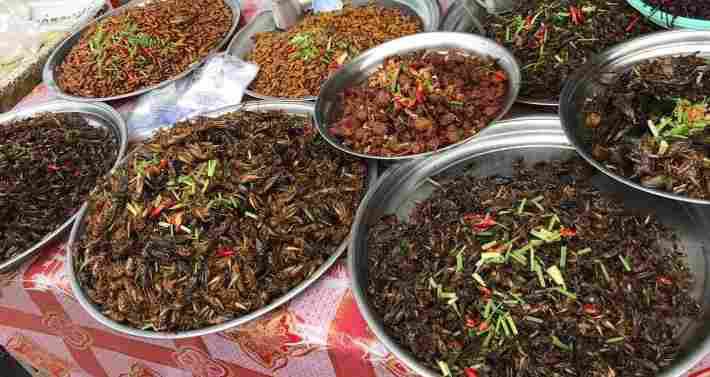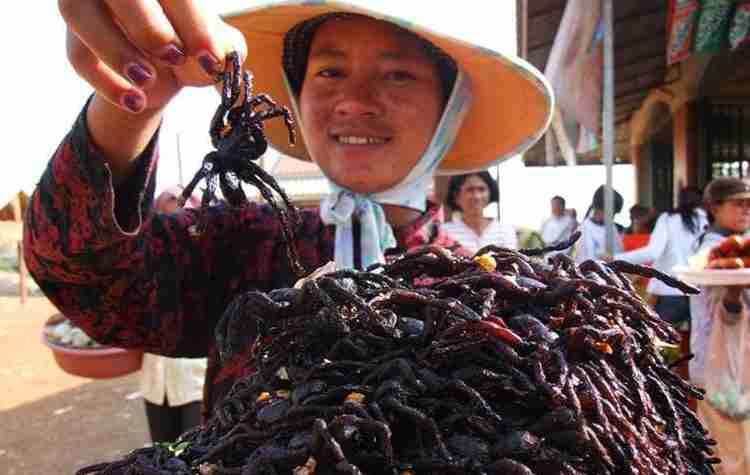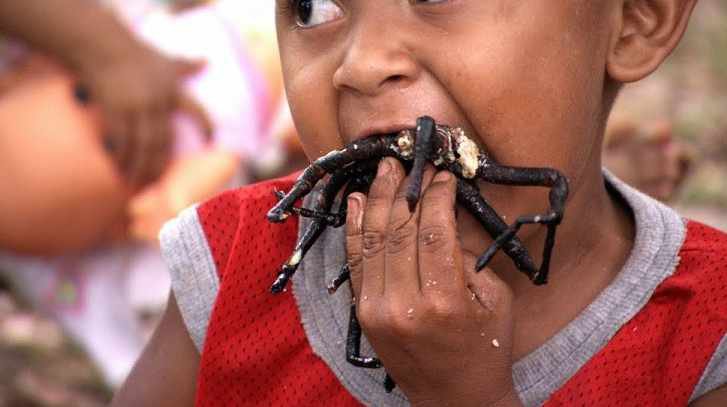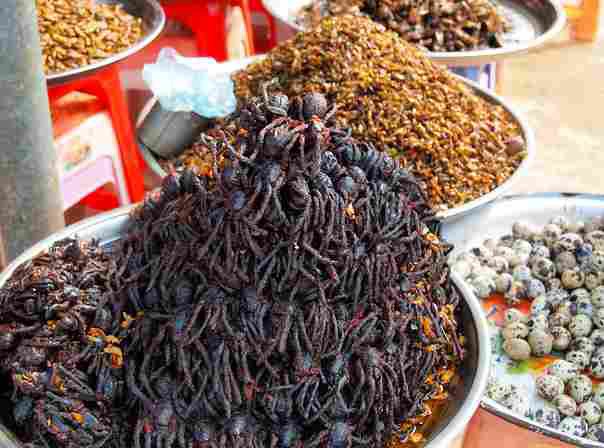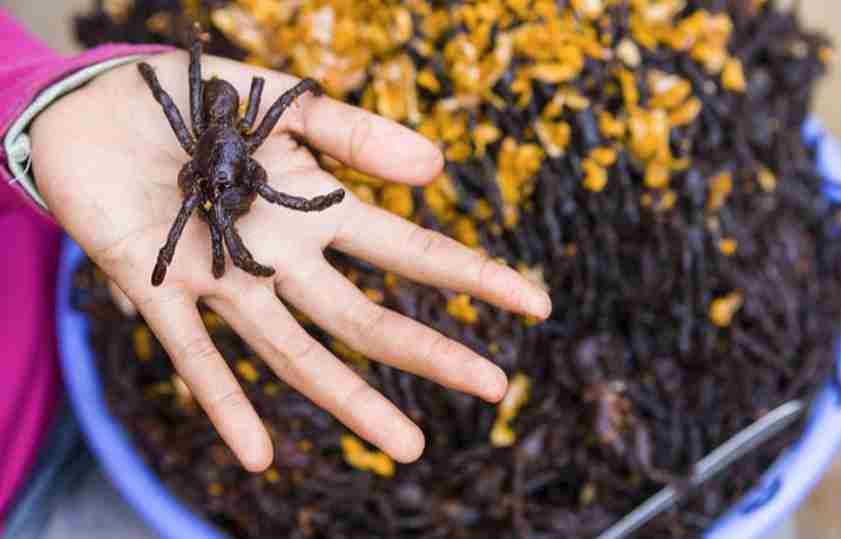There are all sorts of weird and wonderful foods to be found around the globe, and if you’re an avid traveler, you’ve probably sampled a good few at some point. Some, you may have loved and gone on to acquire a taste for them, while others you might want to avoid at all costs!
Entomophagy, for example – the practice of eating insects – has been around since prehistoric times and is a popular food source in most parts of the world, including Central and South America, the African Continent, Asia, Australia, and New Zealand. In fact, believe it or not, 80 percent of the world’s nations eat between 1,000 and 2,000 different species of insects.
These arachnids are such a delicacy that large ones can sell for up to $1 each, a hefty sum in a country where the minimum wage is about $6 a day.
In Southeast Asia, crickets, cicadas, grasshoppers, ants, silkworm pupae, and a variety of beetle grubs are deep fried and sold in the markets alongside other ‘regular’ cuisine.
Even scorpions are a delicacy in many parts of mainland Southeast Asia, but in Cambodia, they take eating insects a step further with a staple diet of tarantula spiders!
Far from being a new fad, hunting spiders for food, or for use in traditional medicine, has been going on in Cambodia for generations. However, the consumption of spiders surged in Cambodia during the mid-1970s when widespread starvation brought about by the repressive, genocidal Khmer Rouge regime, left people with few options for survival.
Despite their grim association with the regime, today these hairy arachnids are now considered to be a delicacy and can be found on sale in markets and restaurants throughout Cambodia.
While they are also eaten in other parts of the world – including neighboring Thailand, parts of India, Papua New Guinea and Venezuela – their popularity in Cambodia is unprecedented. And like many insects, they are rich in protein, folic acid, and zinc!
Spider hunters spend two to three hours a day digging these edible hairy monsters out of their silken burrows where they lie silently in wait for their own unsuspecting prey.
Each tarantula can be sold for about 150 riels, and while that is less than a cent per spider, a good spider hunter can catch up to 200 spiders a day, putting away a tidy sum of between US$5.00 to $7.00, or more – not to be frowned at in a country where the majority of people live on a few dollars a day or less.
Vendors sell their spiders for around 300 riels each and usually sell between 100 and 200 a day, so can also make a similar profit. Cooking teacher Ouch Ratana makes a living selling fried tarantulas on the streets of Siem Reap. He assures that Cambodians really do love to eat spiders.
“Some days I can sell dozens,” he says as he opens up a plastic bag stacked to the brim with tarantulas. “They are delicious — a perfect snack with some cold beer or rice wine. But they are very expensive so people only eat them for a special event, maybe a birthday party and everyone has one or two.”
While there currently seems to be an inexhaustible supply of tarantulas in Cambodia, systematic deforestation throughout the kingdom may be a nail in the coffin for this delicacy and could even lead to a decline in their numbers, say some experts. But for now, munching on spiders shows no sign of declining.
In fact, Cambodia’s Mecca for devouring spiders is as popular as ever. Skuon, a nondescript dusty town about 90 km north of Phnom Penh is the center of this extreme cuisine and continues to grow in popularity with more and more people visiting from the capital to dine on its arachnids.
The people of Skuon first started using the spider’s many generations ago in traditional medicines, as they are thought to be good for heart, throat, and lungs, but by the time Pol Pot’s murderous Khmer Rouge regime had come to an end, they had acquired quite a taste for the hairy critters.
So what does deep-fried tarantula taste like? The legs, which you usually eat first, are nice and crunchy on the outside with a little bit of flesh on the inside, while the head and body have delicate white-colored meat – a cross between chicken and fish, both in taste and texture.
However, the large round, hairy abdomen, which is where all the spider’s organs are, has a rather gamey taste – not for the faint-hearted.
At Cardamom Tented Camp, we don’t have spiders on the menu, but you could well come across a variety of arachnids during one of our treks into the depths of Botum Sakor National Park – along with a diverse range of other hairy and non-hairy insect and animals species. To book a wildlife-infested adventure into the wilds of Botum Sakor National Park, check out our various packages and activities on offer at Cardamom Tented Camp.


